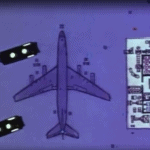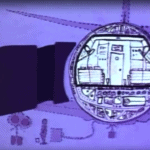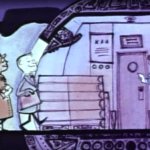Charles and Ray Eames’ Vision of the Jet Age
Share
Charles and Ray Eames, the couple best known for their designs of timeless chairs (think back to the offices of Mad Men: Roger Sterling and Don Draper each kept executive models of Eameses behind their desks). But they also quietly contributed to the midcentury stylings of the jet age.
Most notable was Tandem Sling Seating for airports: sleek, black padded armchairs with a chrome frame attached in a row; designed as much for style as they were for easy maintenance and longevity. The seating continues to be sold by Herman Miller and is found in airports from Kalamazoo-Battle Creek International in Michigan to George Bush Intercontinental in Texas. Lesser known are the molded plywood splints, stretchers and airplane parts the Eameses contributed to the World War II effort, and their catalytic role in the realization of one uncanny airport vehicle.
The Expanding Airport is a 10-minute video the Eameses produced for architect Eero Saarinen to illustrate his concept of mobile lounges to the Federal Aviation Authority when he was commissioned to design Dulles International Airport (“Washington” was added to the name in 1984). While airports were expanding in the 1960s to accommodate the larger commercial jets, Saarinen thought they were dragging down the passenger experience by forcing travelers to walk long distances from their parked cars to their planes. His solution was a cocktail lounge-bar on wheels that would ferry passengers from the airport terminal directly to their aircraft, making the transition a more glamorous affair.
Saarinen’s mobile lounges were adopted, but the concept didn’t quite take off the way he had hoped – none of cars today feature bars, and the actual experience is comparable to riding the subway.
Although mobile lounges, also called Plane-Mates, are still in use at a handful of airports in North America, their replacement by speedier airport links is inevitable. But we’ll have Charles and Ray Eames’ animation, to remind us how a seemingly far-fetched idea, intended to bring joy into air travel, was realized for a brief moment in aviation history.
See “The Expanding Airport” below:






